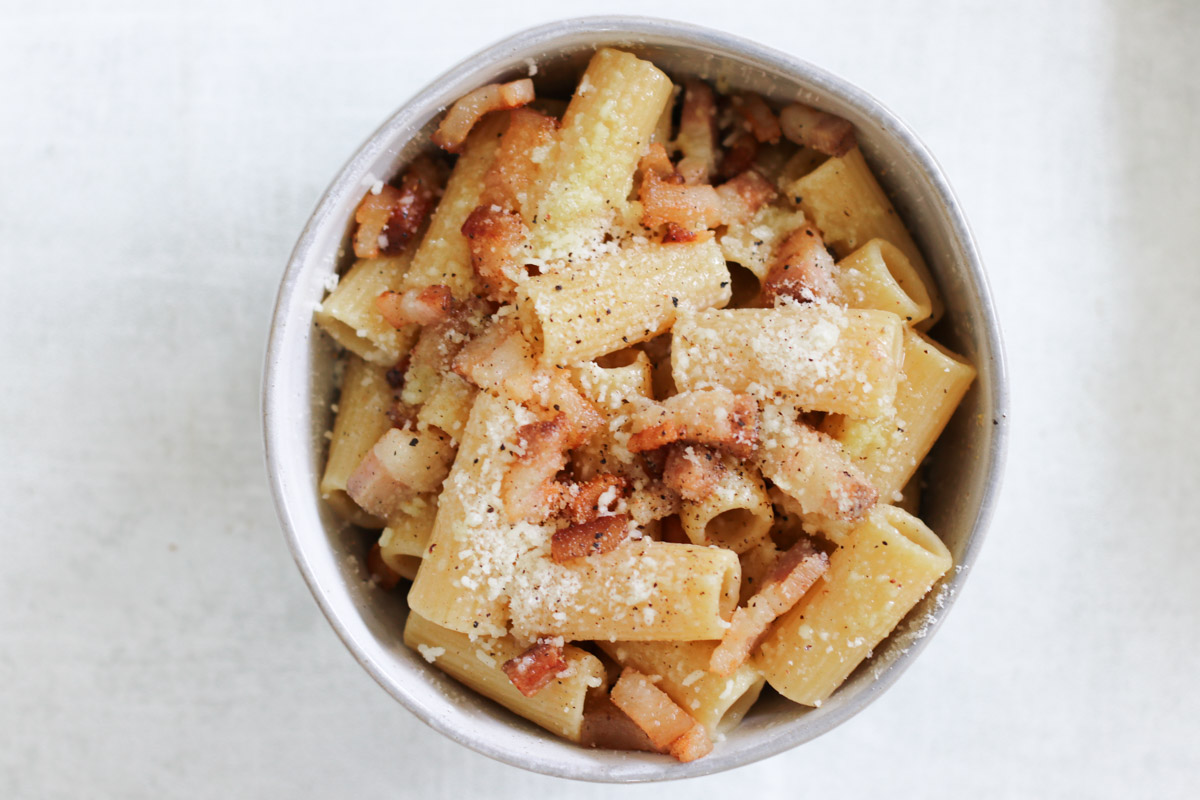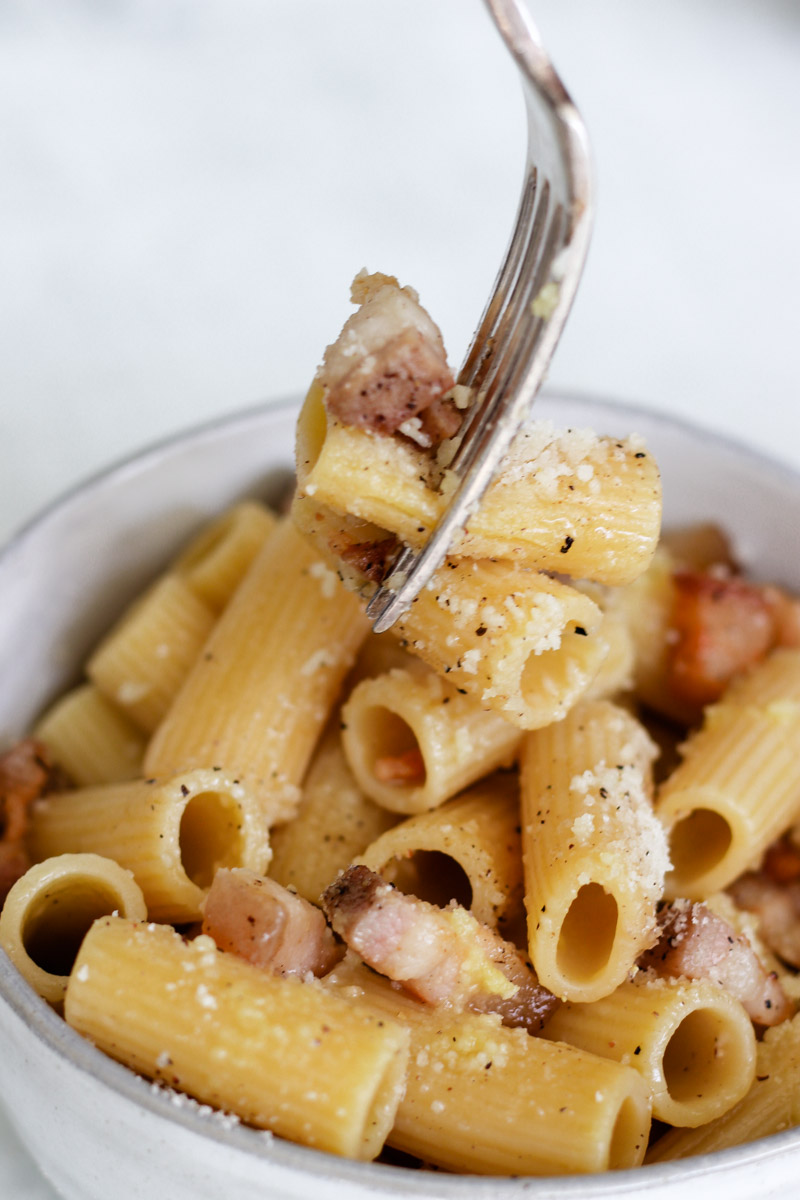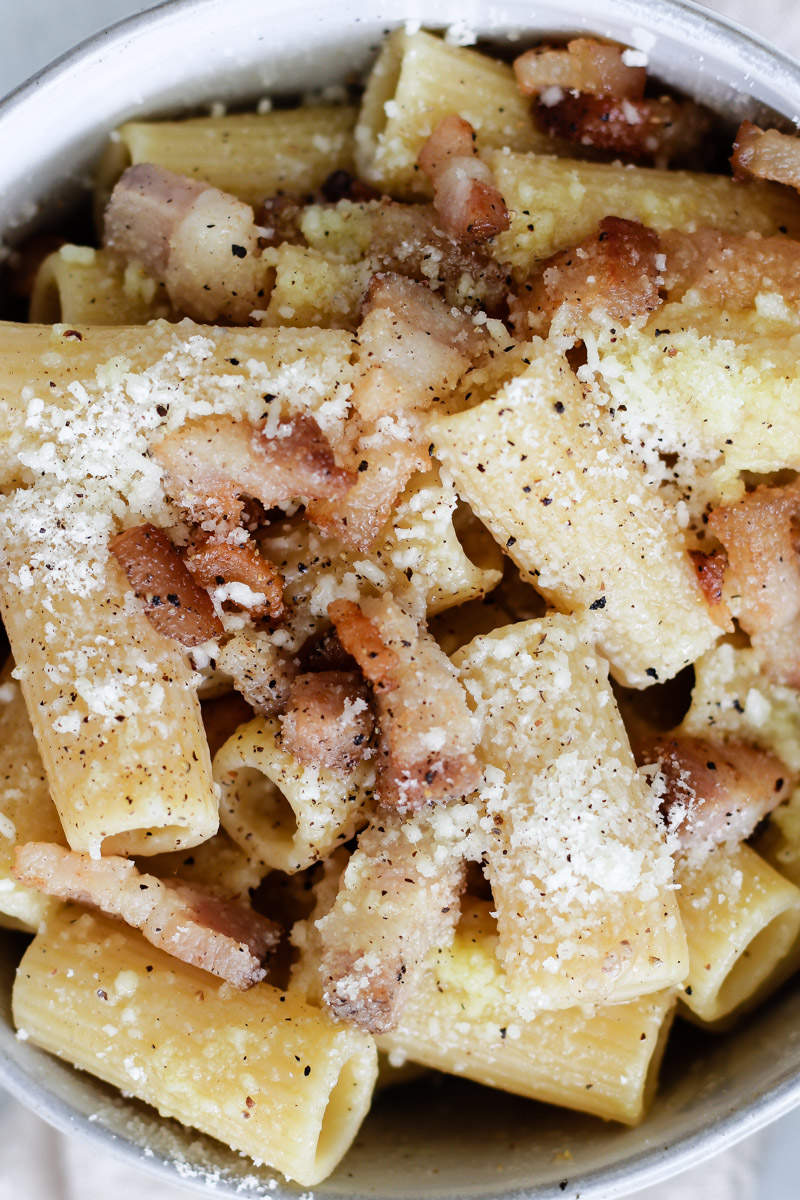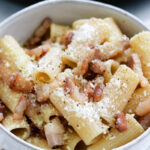Pasta alla gricia is a classic pasta dish from Rome. It's made by combining guanciale (cured pork cheek), pecorino Romano cheese, black pepper, and starchy pasta water. Don't be fooled by the short list of ingredients, this pasta has incredible rich and flavorful taste!

If you've been following along recently, we have been busy enjoying some iconic Roman pasta dishes. We have already shared three of the four classic Roman pastas: carbonara, cacio e pepe, and Amatriciana, and now finally, pasta alla gricia. It was about time we let you take a bite of this less famous recipe, as it's absolutely delicious!
Also, we're so excited to share another Italian pasta recipe that is ready in less than 20 minutes. Pasta alla gricia showcases the essence of Italian cuisine: transforming humble ingredients into captivating dishes. It is easy to make and is packed with delicious flavor!

Jump To
- What is the history of pasta alla gricia?
- Why isn't pasta alla gricia sauce more famous?
- What ingredients are in rigatoni alla gricia?
- How to make pasta alla gricia
- Tips to make the best rigatoni alla gricia
- Can you make this pasta ahead of time?
- How to store leftovers?
- Some other pasta recipes to enjoy:
- Pasta alla Gricia
Why we love pasta alla gricia
- Crispy guanciale: When guanciale is cooked slowly, it produces crispy bits of pork and a lot of tasty fat that can be used to create a smooth sauce.
- The luscious sauce: To make a perfect sauce, cook the pasta to just about halfway in a smaller amount of water than you usually cook pasta, which will result in starchy pasta water that can be used for emulsifying the sauce.
- Perfectly coated pasta: Since the rigatoni finishes cooking in the gricia sauce as it reduces, each pasta piece is perfectly cooked and coated. The tubular shape of rigatoni is perfect to hide the delicious crispy guanciale chunks. Which makes for extra flavorful bites!
Before we get onto this AMAZING pasta recipe...you may be wondering:
What is the history of pasta alla gricia?
You probably only are familiar with Rome's more famous pasta recipes. Gricia should be equally as famious! The reason is that pasta alla gricia is the oldest dish among carbonara, amatriciana, and cacio e pepe. In fact, all of those pasta recipes have their origins in alla gricia.
Actually, la gricia was created before amatriciana. This is because tomatoes were not used in traditional Italian cooking until the 1800s.
But as it is with many Italian recipes, it's hard to know for sure what the exact origins of gricia are. According to some accounts, the origins of the dish can be traced back to Grisciano, a town in the Lazio region, where shepherds in the fields first prepared the dish using pecorino Romano, guanciale, and pasta which were readily available to them at the time.
According to other stories, the term's origin is linked to the Grici, a Rome-based group of breadmakers and food merchants whose history was believed to have roots in Switzerland's Grigioni canton.
We are going to lean more towards the story of the shepherds made this with their handy ingredients. This is absolutely one of our favorite pasta recipes. As soon as you take a bite, it will soon be yours, too!

Why isn't pasta alla gricia sauce more famous?
Pasta alla gricia is usually overshadowed by other more popular Roman pasta recipes. It may be referred to as a" "carbonara minus the eggs" or even as a "white amatriciana," since it's made without tomatoes.

What ingredients are in rigatoni alla gricia?
Made with only 4 ingredients, here is the short list (full printable recipe is below):
Gricia pasta contains only 4 ingredients:
- Pasta – We used rigatoni. You could use penne or even mezze maniche, which is commonly used in gricia. If you want to go the true Roman way, use spaghetti.
- Guanciale – Guanciale is fatty pork cheek (jowl). Since it is a high fat content pork product, it makes the most luscious sauce when the fat melts as the guanciale cooks up. Guanciale has a unique flavor, different than pancetta and bacon.
- Extra-virgin olive oil- I used a little bit of extra-virgin olive oil in the pan.
- Pecorino romano – Pecorino romano is a delicious sheep's milk cheese. Did you know that pecora means sheep (hence, pecorino!). Be sure to look for the real Pecorino Romano and not an imitation "pecorino", which won't melt the same and will not create the same silky sauce.
- Ground black pepper – Freshly ground pepper is ideal. You could even grind the pepper right into the pan. The black pepper adds the perfect flavor of heat. It's not spicy, like red pepper flakes, but it is definitely detectable (keep this in mind if making this for kids).

Gricia is pronounced GREE-cha. Most people from Rome/Lazio pronounce it as GREE-sha because of their pronunciation of the “ch” sound as a “sh” sound.
Spaghetti also would work fine, and is what Romans use. We think the best pasta is a short pasta like rigatoni. It's ridges hold the creamy sauce and are perfect for bites of crispy guanciale. Penne could be used in its place if that's all you have on hand.
Pasta alla gricia happens to be one of the easiest Roman pasta dishes you could cook up at home.
No, it definitely is not since it made with guanciale and pecorino Romano. Guanciale is a pork product and pecorino Romano has rennet (which has rennet)
No, they aren't the same, as carbonara is made with eggs. Gricia's sauce is creamy from the starchy pasta water alone emulsified with the cheese.
No, it is not. It is made with guanciale, which is a pork product, and pecorino, which has rennet.
Yes, just use your favorite gluten-free pasta brand.
Yes, if you can't get pecorino Romano, use Parmigiano Reggiano.
If you can't find guanciale anywhere, you could substitute with pancetta or thick-cut bacon.
Guanciale comes from the Italian word "guancia" which means cheek. Guanciale is comes from the pork cheek (or jowl). And pancetta comes from the Italian world "pancia" which means belly, and it comes from the pork belly. They are made with different spices and cured in different ways.
According to some, pasta alla gricia originated in Grisciano, a town located in the province of Rieti, which is situated in the Lazio region. According to others, the origin of this could be traced back to the grici, a group of breadmakers and food merchants in Rome who allegedly had their roots in the Grigioni canton of Switzerland.

How to make pasta alla gricia
Here is a brief overview of the steps. The full printable recipe is below.
First step is to gather your ingredients. There are not that many, so be sure to have them ready.

First step is to prep the guanciale. You will be discarding the crust. Cut it into as big or small pieces as you prefer. Keep in mind it does shrink a little as it cooks and the fat melts.

As soon as the pasta is a couple minutes before al dente, it gets drained and added immediately to the pan with the guanciale fat. It gets stirred together and you add in some of the cheese.

The final step once you have added in also the guanciale, is to add another dusting of Pecorino Romano. If you like the flavor of ground pepper, go ahead and grind on some more! Serve it up and enjoy this classic Roman pasta recipe! Buon Appetito!
Tips to make the best rigatoni alla gricia
- Guanciale: If you cannot find guanciale, look for pancetta. Bacon will work, but it's not the same. In a pinch, you could substitute with those ideas.
- Cheese: If Pecorino Romano is not available, go ahead and substitute with Parmigiano Reggiano. Be sure you buy authentic pecorino or Parmigiano.
- Salt: I like to cook the pasta with some salt. But keep in mind, this is going to be a salty sauce from the guanciale and the cheese. Taste the pasta as it's cooking, and add some salt to the sauce, if you feel it needs it.
- Pasta water: We use less water to cook the pasta. Using less water makes it more concentrated in starch from the pasta, which helps to loosen create the gricia sauce.
- Keep some pasta water: Be sure to follow the recipe and reserve some of that pasta water. The starchy water the pasta cooks in is key to emulsifying this sauce. It's key to making it creamy and helps the cheese to melt.
- Take care: When you add pasta water to the guanciale fat, it may splatter, so be careful and be aware of that.
- Stir often: Keep on stirring the sauce. Make sure it's in constant movement. When you add the cheese, the pan needs to be off the burner. Too much heat and not enough fast movement will make the cheese clump.

Can you make this pasta ahead of time?
No, this pasta is meant to be enjoyed as soon as you make it!

How to store leftovers?
- To Store: Any leftovers keep nicely in an airtight container in the refrigerator for up to three days.
- To Freeze: I do not recommend freezing this pasta.
Some other pasta recipes to enjoy:
- Sicilian Pasta with Cauliflower
- Pasta alla Norma
- Orecchiette Pasta with Broccoli Sauce
- Ziti al Forno
Pasta alla Gricia
Ingredients
- 9 oz. guanciale
- 1 Tablespoon extra-virgin olive oil
- 1 lb. dried rigatoni pasta
- 2 tsp freshly ground black pepper
- ¾ cup finely grated Pecorino Romano 2½ oz., divided
- Fine sea salt
Instructions
- Prep the guanciale: Place the guanciale on a cutting board and with a sharp knife, carefully slice off and discard the seasoned crust of the guanciale. Slice into ¼-inch-thick slices. Cut the slices into chunks about ½ x 1-inch pieces.
- Cook the guanciale: Heat a large saute’ pan to medium-low. Add in the guanciale and cook it. If your pan is not nonstick, add in some olive-oil. Stir it as it starts to cook up. Cook until it is crispy and a dark golden color (about 10-15 minutes). If you like the guanciale darker and crispier, cook it a few minutes more.
- Reserve the guanciale fat: Once the guanciale has cooked up, use a slotted spoon to remove the guanciale and add it to a small bowl. Reserve the guanciale fat in the pan.
- Boil pasta water: Meanwhile, fill a large pot with 3 quarts of water and bring to a boil. Once it boils, salt the pasta water with a tablespoon of sea salt (less salt is needed than typically used for pasta as the guanciale and cheese are salty).
- Cook the pasta: As soon as the water boils again after adding in the salt, add in the pasta and cook, stirring occasionally, until it’s just about al dente (check the time on your pasta box, as you’ll be cooking it about a bit more than half of the boxes’ recommended cooking time). Set a timer to remind yourself to check it. It will be a little chewy, as it will be a couple minutes before the al dente time, but it will finish cooking with the sauce.
- Heat the black pepper: When the pasta is few minutes before al dente, turn the sauté pan heat with the gaunciale fat to low heat. Add in the freshly ground black pepper. Give the pepper a swirl in the pan and as soon as it foams a little, it’s ready.
- Add pasta water: Carefully scoop out 1 cup of the starchy pasta cooking water and add it immediately to the pan and set aside another ½ cup of the pasta cooking water.
- Raise heat: Turn up the sauté pan heat to medium high and bring to a boil. Use a wooden spoon to stir the water with the fat and let it reduce a little.
- Drain the pasta: When the pasta is before al dente, drain the pasta in a colander and add immediately to the sauté pan.
- Finish cooking the pasta: Keep on cooking the pasta in the pan, stirring with a wooden spoon, and swirling it in the sauce. The sauce will emulsify and become glossy, and the pasta should finish cooking to a perfect al dente. Toss in the cooked up guanciale pieces and stir to combine.
- Remove pan from the heat: Stir in ¼ cup of the Pecorino and stir to combine until it is melted. Stir in another ¼ cup of the Pecorino and keep stirring, until it is melted and has a glossy consistency. If you add the cheese all at once, it may not melt correctly and break the silky emulsion, which will be clumpy. If the sauce is too thick, add in a little bit of the ½ cup of reserved starchy pasta water and stir to loosen it a little.
- Check the seasoning: Taste the pasta. The cheese and guanciale is salty, but if needed, add in a bit of sea salt, and stir to combine.
- Plate up pasta: Serve the pasta immediately. Optional: Sprinkle on the rest of the cheese and add on some more black pepper. Enjoy!
Nutrition Disclaimer
Please keep in mind that the nutritional information presented below is an approximation and may vary depending on the exact ingredients used.
Notes
- Guanciale: Try to find a guanciale that has a simple salt + black pepper cure. There are other cures made with fennel or chile. If that’s the only guanciale you find, that is fine. Cutting guanciale can be tricky. The colder it is, the easier it is to slice. Freeze it for 10-15 minutes just before slicing makes it easier. If you can’t find guanciale, use pancetta or thick cut bacon in its place.
- Pasta: Every brand of pasta will have different cooking times. The goal is to cook the pasta to 2-3 minutes before al dente. The pasta gets transferred (either with tongs, or drained in a colander), right into the pan to emulsify with the sauce. It will finish cooking in the pan. Make sure you don’t overcook it.
- Cheese: Pecorino Romano is the ideal cheese for this pasta, and the traditional cheese. Be sure to grate the cheese on a microplane so it melts better. Do not use “Romano” cheese, as it’s not close in flavor to the authentic Pecorino Romano. Parmigiano Reggiano will work fine in its place. Please do not use Parmesan cheese, as the sauce will not be silky smooth and will not have the right flavor.
- Serve immediately: This is not a pasta to cook ahead of time. As soon as it is ready, serve up the pasta and enjoy it!




Julia says
When I went to Rome about 6 years ago, this was my favorite pasta! I can't remember the name of the trattoria, but this is even better!